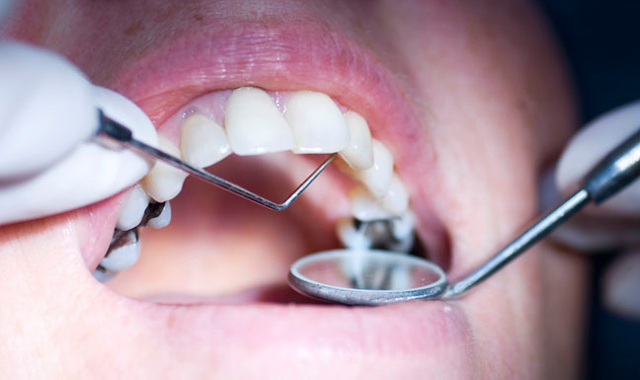5 ways procedures are changing because of bulk fill technologies
The technology behind bulk fill composites is better than ever, resulting in easier usage for clinicians.
There’s no question that the quality of composite dental restorations has improved with better function, esthetics and handling. And as great as they have been, they just keep getting better.

This is particularly apparent in the case of bulk fill composites. Innovation in bulk fill technology has made the materials easier to handle, simpler to use and faster to cure. The ultimate result is a superior restoration. The technology behind these materials is better than ever, and those technologies only make their usage easier for the clinician.
More from the author: 4 things you didn't know you can do with a digital scanner
Click through the slides to learn more.


Traits
Dr. John O. Burgess, DDS, MS, professor and assistant dean for clinical research at the University of Alabama, Birmingham, explains how the current generation of bulk fill composites are giving doctors what they want – and what they need.
“You want good wear resistance if it’s going to be used in a loadbearing area, and most of these will be used in loadbearing areas,” Dr. Burgess explains. “They should also be esthetic and should not adhere to the condenser or the placement instruments that you’re using to contour the composite.”
Bulk fill composites are so called because their function is the ability to fill a large area. In the past, this was accomplished by applying several layers of composite, 2 millimeters at a time. Now, however, bulk fills are able to achieve depths of up to 5 millimeters.
Related reading: 10 common direct dentistry mistakes to avoid
“Right now, you’ve got a few materials that will go right up to 5.2 millimeters, but most of the materials will hit about 4 millimeters,” Dr. Burgess says. “The materials themselves are a little more translucent in order to gain that increased depth of cure. Most composites, prior to bulk fills, would cure about 2 millimeters. This increase of depth of cure is due to a change in the photoinitiators in the composite. The photoinitiators absorb the wavelength of light emitted from your curing light and create radicals, which cause the materials to polymerize.
“Light irradiation starts the polymerization process that hardens the material and then produces a hard, durable restoration,” he continues. “There is an accompanying shrinkage that goes along with that, and there’s a lot of controversy about how much shrinkage is okay. We all knew that if the polymerization shrinkage could be low enough at some point, then bulk curing would be possible. It seems as though that critical shrinkage level has been met.”
New bulk fills have the technology and formulation to deliver restorations with less shrinkage.
“The newer generations have different ways to reduce shrinkage,” explains Dr. Marcos Vargas, BDB, DDS, MS, professor of family dentistry at the University of Iowa. “Mainly, new products like Filtek or Filtek One have a new fragmentation monomer, as 3M calls it. That allows for relaxation of stress when it is polymerizing.”



Handling
Handling has improved with current bulk fill formulations, making placement easier and reducing the opportunities for error.
“You’d like a material that doesn’t stick to the instrument too much,” Dr. Burgess says. “Because if it sticks to the instrument and it’s hard to get off the instrument, that will tend to lift the composite resin and produce voids. You can see voids on radiographs that look like dark lines or a dark hole in the filling material. Those voids weaken the restoration. So, adhering to the instrument is a bad thing for composite resin placement. You can decrease that attachment of the composite resin to the instrument by using an instrument with a gold coating called titanium nitride. These gold-colored tipped instruments cling a little less to the composite. You can also use a little bit of alcohol - just a small amount, just wipe the alcohol on your instrument -- and it won’t attach to the composite resin, so that works out pretty well. But you have to touch that to condense it because you want to make sure that composite resin isn’t in contact with the walls of the cavity preparation.”
Bulk fill handling traits are a function largely of their viscosity. There are two types of bulk curing composite resins: low viscosity and high viscosity.
Trending article: A look at the 2017 Cellerant 'Best of Class' Technology Award winners
“The low viscosity bulk fill flowables should be used with very small preparations,” Dr. Burgess says. “With very small preparations, take your syringe tip, put it in the floor of the cavity preparation and back fill the cavity preparation, and it seals really quite well. Conversely, if you take a very viscous material and try to condense it into a very small cavity preparation, it’s very difficult and voids are often the result of trying to do that.”
For larger preparations, Dr. Burgess recommends a highly viscous material with little flow, which will maintain the proper contour and anatomy in the restoration until it is polymerized.
“The more viscous material will hold its shape as you place it and not have it flow too much, removing the anatomy you just placed into the restoration,” he says. “The low viscosity flowable materials will tend to flow all over and you wind up contouring it a lot with the bur, so it takes a little longer her to do with that way.”
While the viscosity of the material seems to be a straightforward matter, ultimately it seems to depend more on practitioner preference than anything.
“A lot of times composite manufacturers will say, ‘What type of composite resin should we make? A denser filled material or one that’s more flowable?” Dr. Burgess says. “I talk to a lot of practitioners and what keeps coming back again and again is that some people will always like the lower viscosity materials, while other people will inherently like the higher viscosity material. And you cannot dissuade them from that. That’s what they like and that’s what works for them.”



Curing
Bulk fill composites will not harden unless they are light cured, and proper light curing is critical to the success and longevity of the completed restoration.
“The light polymerization is based on mainly on photoinitiators like camphorquinone, but by making the composite more translucent, the depth of cure is increasing because the light can go to a greater depth,” Dr. Vargas says. “We need to make sure it gets enough light to completely polymerize the material.”
To achieve the depths of cure that bulk fills require necessitates a combination of composite formulation, lighting equipment and technique.
“Curing lights have also improved,” Dr. Burgess says. “The average output now is over 1000 mW/cm2 for most curing lights. And that works to your advantage because it allows reduced curing times. Some – not a lot, but some – units that have higher irradiance put out more light, and these curing lights do work better.”
The curing light’s size is also a factor is achieving the best curing results.
More from the author: 4 extreme measures taken in the name of infection control
“You want the unit with the head size that is at least equal to your mandibular first molar,” Dr. Burgess observes. “Because you don’t want to cure the same tooth two or three times simply by moving the curing light from one side of the tooth to the other side of the tooth, so it is advantageous to cover the entire occlusal surface of the tooth and light cure that in one curing cycle, and that’s what these curing lights with larger heads allow you to do.”
The best material formulations and curing light properties mean little if they are undermined by poor technique. How the clinician holds the light and his or her technique is critical to proper curing.
“When you’re holding the curing light, a lot of times what people do is angle the curing light or move it over the top of the tooth,” Dr. Burgess says. “If you do that, you decrease the available energy that the composite resin can absorb, and when you reduce energy, you have a poorly cured final restoration. Placing your curing light as close as possible to the restoration surface being cured, holding your curing light, light curing, and then moving the curing light is the best way to cure. If you angle the curing light or move the curing light, your tendency is to get less energy on the composite, which decreases polymerization producing a more wear prone, less color stable composite.”
Time is saved when curing bulk filled composites. And that time savings does more than just get the patient out of the chair faster.
“You don’t have to cure as many increments,” Dr. Burgess says. “A lot of these materials will polymerize in a shorter amount of time because they are more translucent and allow light to pass through them easier.
“In addition to saving time, they shorten the window of contamination,” he continues. “Most people, when they’re placing composites, don’t use a rubber dam. And if you get a lot of either blood or saliva in-between the layers of composite, then indeed, these materials don’t work as well. The more quickly you can get these restorations placed, the better off you are because that window, that time of contamination, is shortened dramatically.”



Esthetics
For decades, the industry standard material for fillings was amalgam. It got the job done, but it was unsightly, to say the least. With the introduction of composites, esthetics were more easily achievable. For example, as composite is cured, the filler’s index of refraction changes to match the tooth.
“This new generation of Filtek One is becoming more esthetic because it blends better into the tooth structure,” Dr. Vargas observes. “In the past, to make sure a composite polymerized through 5 millimeters, what they did is match very well the optical coefficient between the particles and the resin. The light would transmit to a deeper depth.”
New technologies allow those composites to be translucent enough for proper curing and then adapt to match the tooth’s color.
Related reading: 5 ways new bulk fills are providing better results
“As the material polymerizes, the translucency decreases,” Dr. Vargas says. “That is beneficial because the material has to be very translucent to allow the light to go through. Now, this material is still translucent, letting light through and polymerizing the bottom, but now, as they change to more opacity, they tend to blend a little bit better into the tooth structure, so they’re becoming a little more esthetic.”
“These materials match really well,” Dr. Burgess adds. “We’ve got clinical studies going on with Ivoclar and 3M, and with both of those, the composite material matches to tooth very well. These new composites are a little more translucent, which not only increases light transmission but also allows the material to have a chameleon effect. It blends in better with the tooth, so you’ll find, even with these bulk fill composites, you’re matching the tooth better than you were with the material that was more opaque.”



Placement
The materials’ improvements have made them ideal for most – but not all – locations in the mouth. A lot of that has to do with its translucency, not its performance.
“Let’s say you’re trying to use it to do a Class IV,” Dr. Vargas says. “The material is just too translucent to be used in the front of the mouth, so I think it’s related more to the posterior of the mouth, Class I, Class II and core buildups, because of its esthetic properties. It has adequate or good mechanical properties, so it’s related more to the posteriors.
“They’re coming out with new, different formulations to make this material’s shrinkage reduced,” he adds. “That’s important because by placing that bigger increment, normally a higher stress will occur. But now these big increments, because of the technology, is allowing us to do these bigger increments with less shrinkage and stress.”
Trending research: Can dentists use squid ink to check for gum disease?
Whether clinicians decide to use a low viscosity or high viscosity bulk fill really doesn’t matter from a performance standpoint. The newer formulations of flowables are just as durable as their thicker counterparts.
“The impression would be that the bulk fill flowables do not have very good wear resistance,” Dr. Burgess observes. “Manufacturers have learned how to increase the filler loading, meaning there are more filler particles in the composite without altering the viscosity. The new flowables will still flow well, but wear like a conventional composite. These flowable materials, even though they are flowable, have a much higher filler rate than they did 10 years ago. The materials have all evolved. They’ve become more translucent. The low viscosity bulk filled flowables are not an inferior product to the high viscosity material.”
Bulk fill composites have come a long way from their initial formulation, and those improvements mean great things for their usage, their placement and their esthetics.
